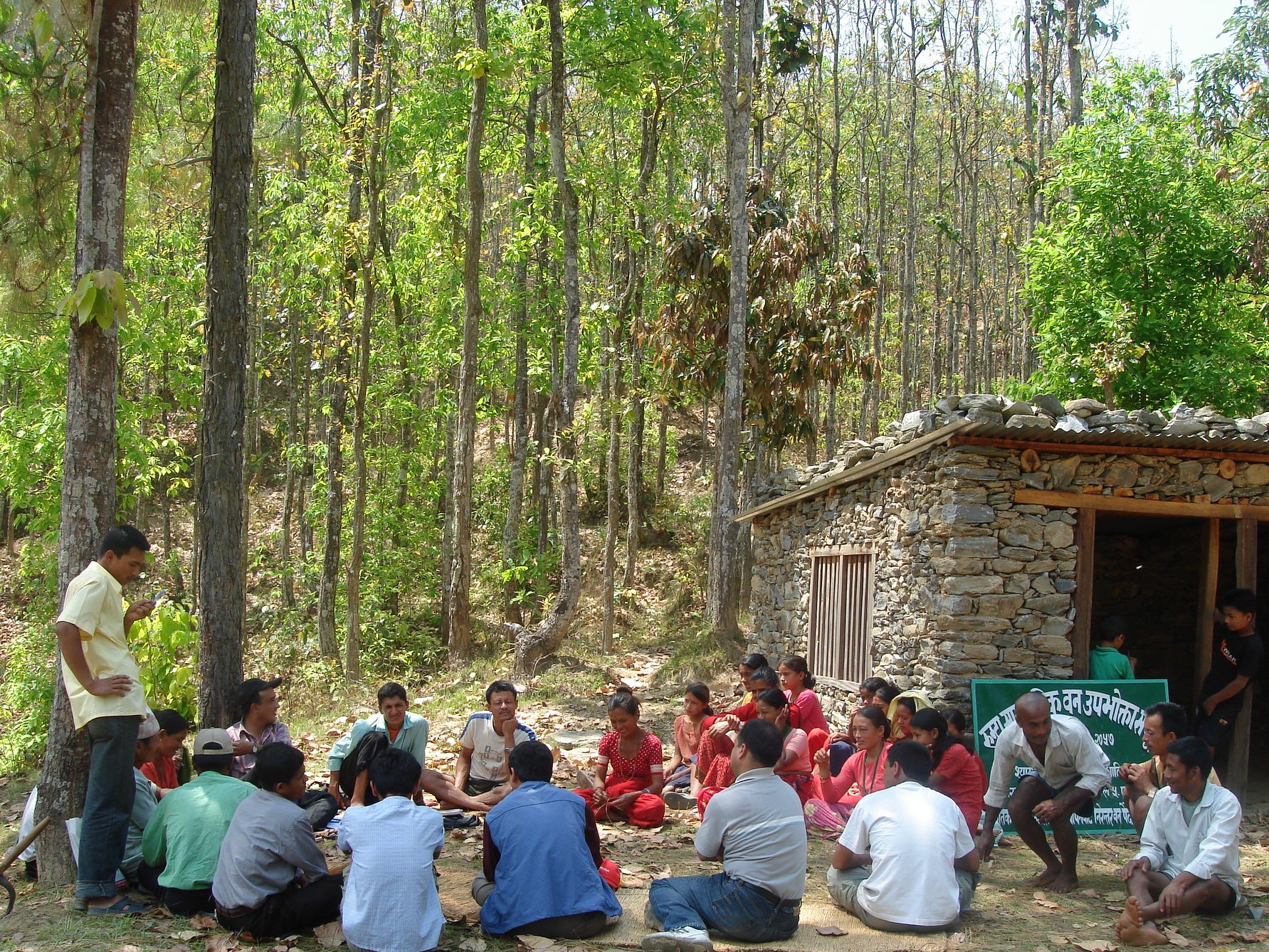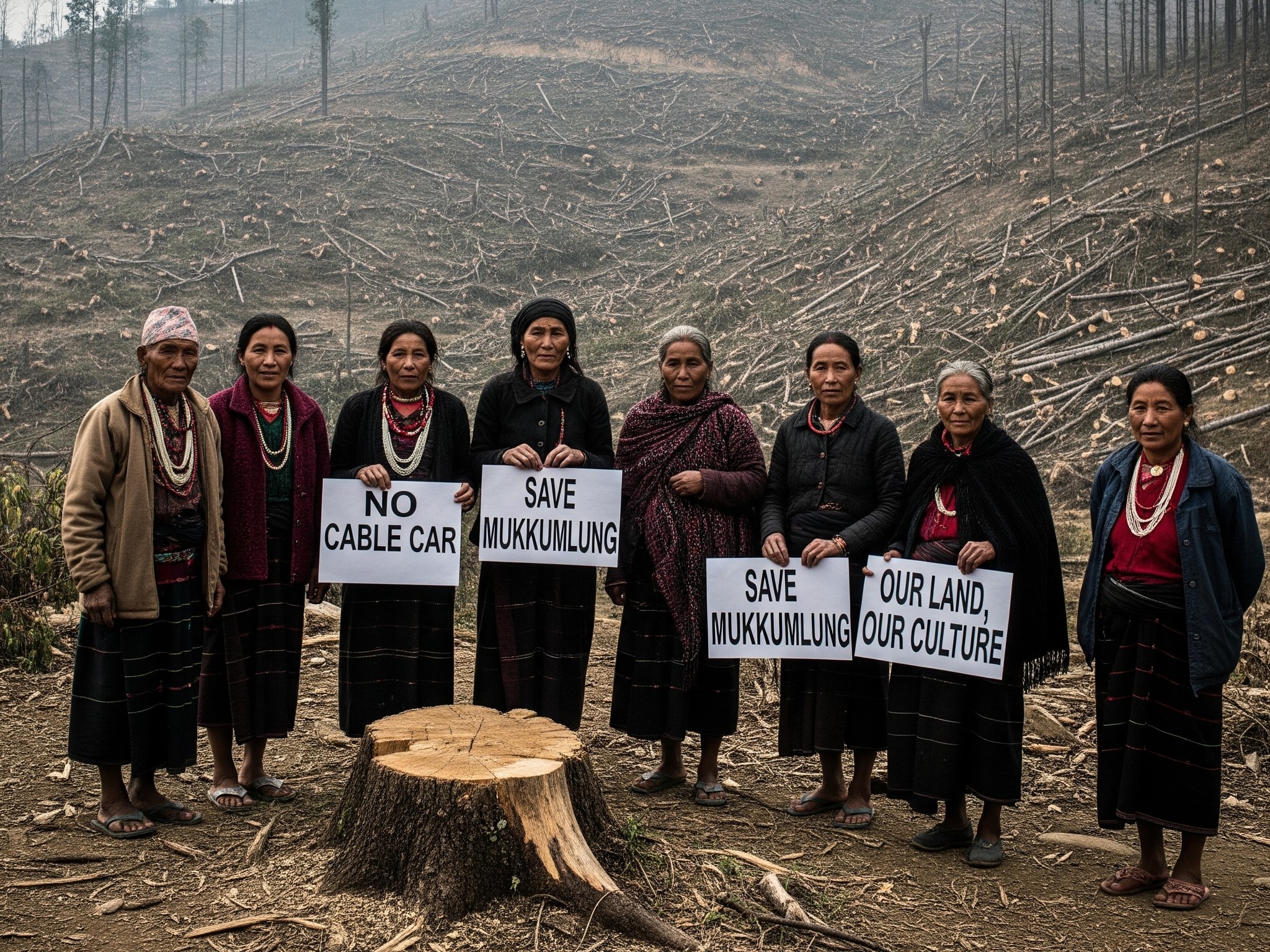Despite Nepal's strengthened environmental assessment (EA) laws, the quality of reports remains poor due to financial interests, ineffective public participation, and inadequate data. This leads to environmental injustices, particularly for marginalized communities whose intersectional vulnerabilities and traditional knowledge are often ignored.

July 07, 2025

An AI-generated image of deforestation showing the environmental impact of development.
Photo: Gemini AI
When a development project is designed without the meaningful consent of the people, failure is assured. Environmental assessments in Nepal intended to prevent such injustices, are often reduced to symbolic checklists.
An example of this ignorance is the ongoing Pathivara Cable Car Project, which completely ignores the spiritual and cultural significance of Pathivara Hill to the Yakthung (Limbu) community. This reflects a broader failure of the environmental assessment process.
“This case demonstrates how procedural development frameworks continue to marginalize those most affected by such projects,” said Tanuja Pandey, a lawyer and founder of Harin Nepal.
This is not an isolated case where genuine public concern has been avoided, ignored, and even punished.
The Upper Karnali project offers another disturbing parallel. According to Pandey, the environmental assessment process there was neither inclusive nor accessible to Tharu, Dalit, and impoverished rural households. Though documents formally recorded public consultations, many community members said that cultural, environmental, and economic impacts were never clearly communicated.
Nepal isn’t short of environmental laws. On the contrary, the country has crafted a relatively strong legal foundation to govern environmental assessments.
“The introduction of the Environment Protection Act, 2019 (EPA, 2019) and Environment Protection Regulation, 2020 (EPR, 2020) has made the Environment Assessment (EA) mechanism in Nepal more rigorous,” said Ramesh Dahal, an environment specialist.
The EPA and EPR introduced a tiered screening system that classifies projects into Brief Environmental Study (BES), Initial Environmental Examination (IEE), and Environmental Impact Assessment (EIA) based on scale, sensitivity, and potential impact.
“However, even though these acts and regulations mandate project-specific information strengthening the capacity of the overall assessments, the quality of reports has only slightly improved,” Dahal added.
He points to a recurring pattern: developers prioritizing financial expediency over environmental responsibility, especially when it comes to mitigation costs.
Public participation is enshrined in Nepal’s environmental laws — but in practice, it’s often reduced to a rushed formality.
Mechanisms of public participation fail even with legal mandates in place. Public hearing requirements for environmental assessments are explicitly mentioned in both the EPA and EPR. These are to be conducted for all three: BES, IEE, and EIA. The hearings are documented and added as an essential part of the reports.

A representational image of public participation.
Photo: Flickr/ USAID Biodiversity & Forestry
“Even though assessment reports don’t get passed without public participation, clients try to find ways out of adequate public participation,” Dahal said.
Pandey echoes this concern, describing how public hearings — if conducted at all — are often held in inaccessible languages, in distant locations, or with little notice.
“Public consultation, on paper, is a powerful democratic tool. But in Nepal, they are routinely rushed, poorly advertised, or conducted in official languages that many locals do not understand,” said Pandey.
She noted environmental assessments are treated as a procedural formality rather than a tool for collective decision-making.
Both experts argue that the seven-day window for public feedback on EA drafts is wholly inadequate, especially for those already facing structural exclusion. “It is not only unrealistic but structurally unfair, particularly for Indigenous peoples, Dalits, women, and those living in geographically isolated areas.”
Behind the scenes of a project’s environmental clearance lies an invisible crisis: weak data, poor tools, and missing science.
The inadequacies in data and information affect not only the technical validity of environmental assessments but also the extent of public participation, accountability, and transparency throughout project implementation.
“Not even Geographic Information System (GIS) expertise is demanded for environmental assessments in Nepal,” said Dahal.
Globally, GIS mapping and remote sensing are essential to understanding a project’s potential footprint. Without these tools, Dahal warns, environmental assessments become subjective and speculative, rather than grounded in evidence.
Even when data does exist, it rarely reaches the people it’s supposed to inform.
Another aspect of data and information is accessibility. In Nepal, data related to environmental assessments may be published on government websites, but they are not truly accessible.
As Pandey notes, "For example, the Ministry of Forests and Environment (MoFE) posts draft EIA reports on its website for public review. However, many local people may lack literacy, internet access, or time to navigate these lengthy technical reports and provide written feedback."
In other words, formality does not equal fairness. When project documents are inaccessible in both language and format, the promise of “public consultation” rings hollow.
Pandey emphasizes the need to translate documents into local languages to ensure prior and informed consent, protect dissenting voices, and center the knowledge of communities, especially those on the frontlines of environmental injustice.
If the rules are the same, why do some projects follow them more strictly than others? Dahal points to jurisdictional inconsistencies in how environmental assessments are applied.
“When the Department of Mines and Geology carries out the extraction of sand from hills, strict environmental standards are met. But when extraction is performed from rivers by the local government, the same standards are not met, since local governments are free to make their own decisions.”
This is where civil society organizations (CSOs) and legal experts play a crucial role in plugging the gaps.
“CSOs and legal experts ensure that EAs are not merely technical checklists. CSOs serve as critical watchdogs monitoring whether assessments meet legal and scientific standards, scrutinizing environmental and social impacts, and advocating for the rights of affected communities.”
Pandey believes legal experts can interpret and contextualize environmental laws, make complex regulatory frameworks more accessible to communities, and initiate legal interventions when rights are violated or due process is ignored.
While environmental assessments often measure the number of trees cut or carbon emitted, they rarely capture who bears the burden.
“Indigenous peoples face cultural erasure and loss of ancestral territories due to unchecked development projects and extractive industries that prioritize profit over people,” said Pandey.

AI-generated representational image of protestors in front of a recently deforested section of Pathibhara Hill.
Photo: Gemini AI
“Women, especially from marginalized groups, bear the brunt of climate impacts... while being systematically excluded from decision-making processes.”
She adds that communities in remote Himalayan villages or the Terai plains face land grabs, floods, and glacial melt — all made worse by poor governance and exclusion from planning processes.
“Yet, these very communities — women, Indigenous peoples, and farmers — are not just victims; they are defenders, often without recognition or resources.”
Nepal’s environmental assessments are not just technical documents — they are political tools. Whether they serve as instruments of protection or vehicles for exclusion depends entirely on how they’re applied.
As the Pathivara and Upper Karnali cases show, the cost of ignoring communities is never just procedural — it is deeply personal, cultural, and irreversible. And until consultations become genuinely inclusive, data becomes scientifically robust and publicly accessible, and marginalized voices are centered, the system will continue to authorize harm in the name of development.

By sharing valuable information and sparking inspiration, we aim to foster growth, innovation and brighter opportunities for future generations.
Contact us